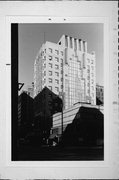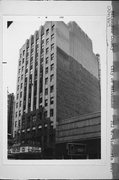| Additional Information: | A 'site file' exists for this property. It contains additional information such as correspondence, newspaper clippings, or historical information. It is a public record and may be viewed in person at the Wisconsin Historical Society, State Historic Preservation Office.
See Mark Latus' Files.
Art Deco skyscraper in downtown Milwaukee, with polished granite ornamenting the lower facade. The theater was designed by Rapp and Rapp, specialists in theater planning, to seat 2431 persons and was one of the largest in Milwaukee. The elaborate interior (pictured in Headley, p. 7) inspired advertising like: "within the dreamlike portals of this enchanted playhouse, is imparted a breath of the medieval French and the ultra modernistic where patrons will glory in the beauty of its inspiring environment". The theater was subdivided in the 1960s.
Warner Bros. Theaters was the owner of the theater and offices in 1930.
In the early twentieth century, West Wisconsin (then Grand) Avenue was Milwaukee's premier shopping street and theater district, thanks largely to nearby major hotels and streetcar lines. Around Grand Avenue and Third Street in particular, nightlife bustled in nickelodeons, vaudeville halls, restaurants, and taverns. Then in the 1920s, elaborate movie palaces began to replace the smaller live stages and picture houses.
The last grand theater built here was the Warner, named for the Warner Brothers studio that owned it. Chicago’s Rapp and Rapp, a highly prolific and influential theater-design firm, created the twelve-story, limestone-clad theater and office structure. From the outside, it is a chaste composition. But theatergoers of the 1930s stepped inside to find one of the most fabulous cinema interiors in Wisconsin. Rich if somewhat schizophrenic, it began with a glittering gold-and-silver Art Deco lobby. From there, movie patrons moved into a 2,500-seat auditorium, fantastically decorated in the French Neo-Baroque style (a favorite Rapp and Rapp design scheme). Lavish ornamental plasterwork and hardwood trim imported from Italy and South America embellished the walls and ceilings, and murals depicted scenes of eighteenth-century French aristocratic life. (In 1973 a ceiling was built beneath the balcony, creating an upper and a lower theater, but the upper one still reflects the grandeur of the original auditorium.)
Jubilant fanfare greeted the Warner’s opening in 1931. It ranked as Milwaukee’s favorite movie venue throughout the 1930s and 1940s when Hollywood's allure reached its zenith, and movie attendance peaked. The Warner closed in June 1995. |
|---|
| Bibliographic References: | MILWAUKEE HISTORIC BUILDINGS TOUR: KILBOURNTOWN, CITY OF MILWAUKEE DEPARTMENT OF CITY DEVELOPMENT, 1994.
Permit.
Latus and Young, Downtown Milwaukee (Milw. Landmarks Commission, 1978) p. 98-100.
Headley, Robert, "The Theaters of Milwaukee", Journal of the Theater Historical Society, 1971, v. 3, no. 1, p. 4-7.
Buildings of Wisconsin manuscript. |
|---|





